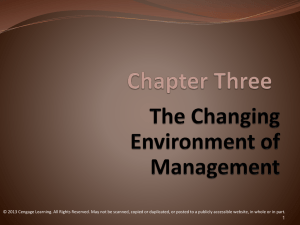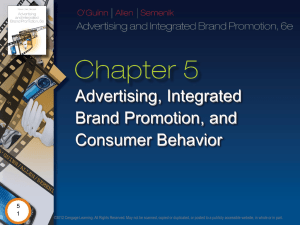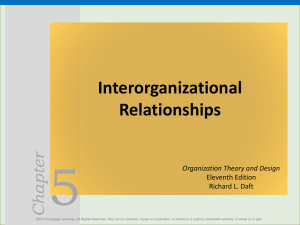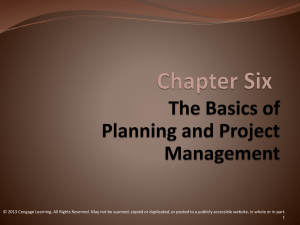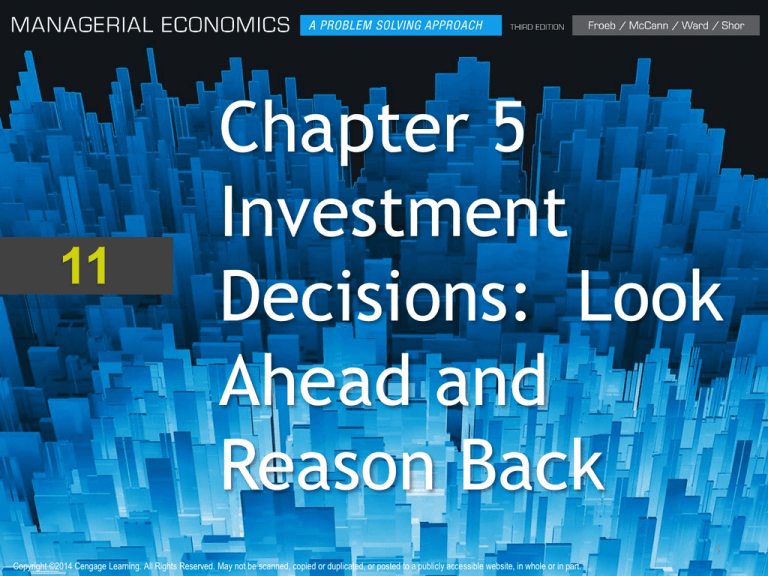
11
Chapter 5
Investment
Decisions: Look
Ahead and
Reason Back
1
Copyright ©2014 Cengage Learning. All Rights Reserved. May not be scanned, copied or duplicated, or posted to a publicly accessible website, in whole or in part.
Chapter 5 – Summary of main
points
•
Investments imply willingness to trade dollars in the present for
dollars in the future. Wealth-creating transactions occur when
individuals with low discount rates (rate at which they value
future vs current dollars) lend to those with high discount rates.
•
Companies, like individuals, have different discount rates,
determined by their cost of capital. They invest only in projects
that earn a return higher than the cost of capital.
•
The NPV rule states that if the present value of the net cash flow
of a project is larger than zero, the project earns economic profit
(i.e., the investment earns more than the cost of capital).
•
Although NPV is the correct way to analyze investments, not all
companies use it. Instead, they use break-even analysis because it
is easier and more intuitive.
•
Break-even quantity is equal to fixed cost divided by the
contribution margin. If you expect to sell more than the breakeven quantity, then your investment is profitable.
Copyright ©2014 Cengage Learning. All Rights Reserved. May not be scanned, copied or duplicated, or posted to a publicly accessible website, in whole or in part.
Chapter 5 – Summary (cont.)
• Avoidable costs can be recovered by shutting
down. If the benefits of shutting down (you
recover your avoidable costs) are larger than the
costs (you forgo revenue), then shut down. The
break-even price is average avoidable cost.
• If you incur sunk costs, you are vulnerable to
post-investment hold-up. Anticipate hold-up and
choose contracts or organizational forms that
minimize the costs of hold-up.
• Once relationship-specific investments are made,
parties are locked into a trading relationship
with each other, and can be held up by their
trading partners. Anticipate hold-up and choose
organizational or contractual forms to give each
party both the incentive to make relationshipspecific investments and to trade after these
investments are made.
Copyright ©2014 Cengage Learning. All Rights Reserved. May not be scanned, copied or duplicated, or posted to a publicly accessible website, in whole or in part.
Introductory anecdote
•
In summer 2007, Bert Matthews was contemplating purchasing a 48unit apartment building.
• The building was 95% occupied and generated $550,000 in annual profit.
• Investors expected a 15% return on their capital
• The bank offered to loan Mr. Matthews 80% of the purchase price at a rate
of 5.5%
•
Mr. Matthews computed the cost of capital as a weighted average of
equity and debt.
• .2*(15%) + .8*(5.5%) = 7.4%
• Mr. Matthews could pay no more than $550,000/7.4% = $7.4 million and still
break even.
•
Mr. Matthews decided not to buy the building. A good decision – one
year later, the cost of capital was 10.125% and Mr. Matthews could
offer only $5.4 million for the building.
•
This story illustrates both the effect of the bursting credit bubble on
real estate valuations and, more importantly, the relevant costs and
benefits of investment decisions.
Copyright ©2014 Cengage Learning. All Rights Reserved. May not be scanned, copied or duplicated, or posted to a publicly accessible website, in whole or in part.
Background: Investment
profitability
• All investments represent a trade-off between
possible future gain and current sacrifice.
• Willingness to invest in projects with a low rate of
return, indicates a willingness to trade current
dollars for future dollars at a relatively low rate.
• This is also known as having a low
discount rate (r).
• Individuals with low discount rates would
willingly lend to those with higher discount
rates.
Copyright ©2014 Cengage Learning. All Rights Reserved. May not be scanned, copied or duplicated, or posted to a publicly accessible website, in whole or in part.
Determining investment
profitability
• The current/future trade-off can be calculated by,
• Compounding
•
•
Xt+1=(1+r) Xt
Xt+s=(1+r)s Xt
• Discounting (the opposite of compounding)
•
Xt+1/(1+r)= Xt
•
Xt+s/(1+r)s= Xt
• Discussion: If my discount rate is 10%, would I lend
to or borrow from someone with a discount rate of
15%?
• What does this say about behavior?
Copyright ©2014 Cengage Learning. All Rights Reserved. May not be scanned, copied or duplicated, or posted to a publicly accessible website, in whole or in part.
Present value and investment
decisions
• Companies also have discount rates, which are
determined by cost of capital.
• A company’s cost of capital is a blend of debt
and equity, its “weighted average cost of
capital” or WACC
• Time is a critical element in investment decisions
• cash flows to be received in the future need to be
discounted to present value using the cost of capital
• The NPV Rule: if the present value of the net cash
flows is larger than zero, the project if profitable.
Copyright ©2014 Cengage Learning. All Rights Reserved. May not be scanned, copied or duplicated, or posted to a publicly accessible website, in whole or in part.
The NPV rule in action
• For this example the company’s cost of capital is 14%
• To determine profitability, discount future inflows and outflows
to compare with the initial investment – here $100
Copyright ©2014 Cengage Learning. All Rights Reserved. May not be scanned, copied or duplicated, or posted to a publicly accessible website, in whole or in part.
NPV and economic profit
• Projects with a positive NPV create economic profit.
• Only positive NPV projects earn a return higher than the
company’s cost of capital.
• Projects with negative NPV may create accounting
profits, but not economic profit.
• In making investment decisions, choose only projects
with a positive NPV.
Copyright ©2014 Cengage Learning. All Rights Reserved. May not be scanned, copied or duplicated, or posted to a publicly accessible website, in whole or in part.
Background: break-even quantities
• The break-even quantity is the amount you need
to sell to just cover your costs
• At this sales level, profit is zero.
• The break-even quantity is Q=FC/(P-MC), where FC
are fixed costs, P is price, and MC is marginal cost
• (P-MC) is the “contribution margin” – what’s left
after marginal cost to “contribute” to covering fixed
costs
Copyright ©2014 Cengage Learning. All Rights Reserved. May not be scanned, copied or duplicated, or posted to a publicly accessible website, in whole or in part.
Decision making example: Nissan
truck
• Nissan’s popular truck model, the Titan, had only two years
remaining on its production cycle. Redesigning the “Titan”
would cost $400M.
•
•
•
•
Cost of capital was 12%, implying annual fixed cost of $48M
Contribution margin on each truck is $1,500
Break-even quantity is 32,000 trucks
The decision to redesign or not came down to a break-even
analysis
• Nissan had a 3% share of the market, implying only 12,000
Titan sales per year – not enough to break even.
• Instead they decided to license the Dodge Ram Truck, which
would reduce the fixed cost of redesign, and a lower breakeven point.
• After the Government took over Chrysler, Nissan reconsidered
Copyright ©2014 Cengage Learning. All Rights Reserved. May not be scanned, copied or duplicated, or posted to a publicly accessible website, in whole or in part.
Deciding between two technologies
• In 1983, John Deere was in the midst of building a
Henry-Ford-style production line factory for large 4WD
tractors
• Unexpectedly, wheat prices fell dramatically reducing demand
for large tractors
• Deere decided to abandon the new factory and instead
purchased Versatile, a company that assembled tractors
in a garage using off-the-shelf components
• A discrete investment decision – the factory had big FC and small MC,
Versatile had small FC but bigger MC
• Remember this advice: Do not invoke breakeven analysis to justify higher prices or
greater output.
Copyright ©2014 Cengage Learning. All Rights Reserved. May not be scanned, copied or duplicated, or posted to a publicly accessible website, in whole or in part.
The decision to shut-down
• Shut-down decisions are made using break-even
prices rather than quantities.
• The break-even price is the average avoidable cost
per unit
• Profit = Rev-Cost= (P-AC)(Q)
• If you shut down, you lose your revenue, but you
get back your avoidable cost.
• If average avoidable cost is less than
price, shut down.
• Determining avoidable costs can be difficult.
• To identify avoidable costs firms use Cost Taxonomy
Copyright ©2014 Cengage Learning. All Rights Reserved. May not be scanned, copied or duplicated, or posted to a publicly accessible website, in whole or in part.
Cost Taxonomy
Copyright ©2014 Cengage Learning. All Rights Reserved. May not be scanned, copied or duplicated, or posted to a publicly accessible website, in whole or in part.
Using the cost taxonomy
• Example problem:
• Fixed cost (FC)=$100/year
• Marginal costs (MC)=$5/unit
• Quantity (Q)=100/year
• What is the break-even price for this scenario?
• How low can prices go before shut down is
profitable?
Copyright ©2014 Cengage Learning. All Rights Reserved. May not be scanned, copied or duplicated, or posted to a publicly accessible website, in whole or in part.
Sunk costs and post-investment
hold up
• National Geographic can reduce shipping costs by
printing with regional printers.
• To print a high quality magazine, the printer must buy a
•
•
•
•
$12 million printing press.
Each magazine has a MC of $1 and the printer would
print 12 million copies over two years.
The break-even cost/average cost is $7 = ($12M / 2M
copies) + $1/copy
BUT once the press is purchased, the cost is sunk and
the break-even price changes.
Because of this the magazine can hold up the printer by
renogiating the terms of the deal – because the price of
the press is unavoidable, and sunk, the break-even
price falls to $1, the marginal cost.
Copyright ©2014 Cengage Learning. All Rights Reserved. May not be scanned, copied or duplicated, or posted to a publicly accessible website, in whole or in part.
Sunk costs and post-investment hold
up (cont.)
• Always remember the business maxim “look ahead and
reason back.” This can help you avoid potential hold up.
• Before making a sunk cost investment, ask what you will
do if you are held up.
• What would you do to address hold up?
• One possible solution to post-investment hold-up is
vertical integration.
Copyright ©2014 Cengage Learning. All Rights Reserved. May not be scanned, copied or duplicated, or posted to a publicly accessible website, in whole or in part.
Vertical integration
• Example: Bauxite mine and alumina refinery
• Refineries are tailored to specific qualities of ore
• The transaction options are:
•
•
•
•
Spot-market transactions
Long-term contracts
Vertical integration
• Vertical integration refers to the common
ownership of two firms in separate stages of the
vertical supply chain that connects raw materials
to finished goods
Discussion: How is vertical integration a solution to
hold up?
• Contractual view of marriage
• What is the hold-up problem?
Copyright ©2014 Cengage Learning. All Rights Reserved. May not be scanned, copied or duplicated, or posted to a publicly accessible website, in whole or in part.



